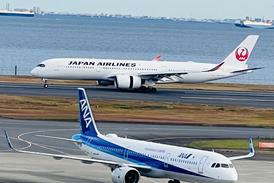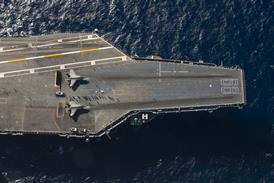There is no doubt, even among French commentators, that the privatisation of Thomson SA has been bungled, leaving the restructuring of the European aerospace industry little further than the launch pad. The latest failure to agree will undoubtedly prove to be a temporary setback, but it still means that, as far as consolidation of European industry is concerned, 1996 will close with a whimper. The year-end was supposed to see the sell-off of Thomson and the Aerospatiale/Dassault fusion virtually settled. Instead, it now looks as if neither will occur until well into 1997.
Meanwhile, the US aerospace industry continues its march towards further consolidation. This week's disclosure that Boeing has offered subcontracting work on its new 747-600 programme to McDonnell Douglas underlines the apparent ease with which US industry can adapt to changing circumstances.
Merging two of Europe's largest defence electronics manufacturers, or selling one off to the other, would, at a stroke, have created a company the match of any in the USA. While laudable in intent, the decision favouring Lagardère's bid for Thomson over that of Alcatel now seems to have been fatally flawed. The French prime minister, Alain Juppé, selected Lagardère in the face of much opposition from ministers, senior aerospace officials (including the presidents of Aerospatiale and Dassault) and the unions.
Most of the dissent - and the reason the privatisation committee rejected the Lagardère plan - centred on proposals to sell the Multimedia consumer arm of Thomson to Korea's Daewoo Industries. Unfortunately, Thomson Multimedia is so badly in debt that it required a French Government hand-out (called "recapitalisation") of Fr10 billion ($1.2 billion) to make the sale palatable to Daewoo.
Thus, the sell-off became an emotionally-charged issue. "Why should the Koreans benefit from French taxpayers' money so that it can compete with with other European consumer electronics companies?" ran the argument. Even the European Commission seemed to be against the proposal, asking the French Government only days before the privatisation deadline to clarify several key elements of the deal. The other component of the sale - the incorporation of the Thomson CSF defence arm into Matra, attracted less opposition, but was still heavily criticised.
The Government-commanded Dassault/ Aerospatiale fusion is another potential problem area which threatens to slow the European rationalisation process. It is well known that the Dassault family has never warmed to the idea, and yielded to the French Government's timetable only minimally, while attacking the plan behind the scenes.
The end-of-year deadline for the two companies to produce precise details of how the merger will be carried out is unlikely to produce anything more than a carefully worded communiqué, with the possibility of no real movement until the privatisation of Aerospatiale - itself a major, unresolved issue - is decided.
It could be that it is the commercial, rather than the military, aerospace industry that produces the impetus to break the log jam. The welcome news that the Airbus Industrie partners are to bring Italy's Alenia closer to the consortium (by including it in all future projects) points the way towards a single competitive European commercial-aerospace industry based around the Airbus product line.
The need now is to push through as rapidly as possible the creation of an Airbus company, as opposed to a consortium. It must be hoped that the remaining areas of dispute will be swiftly overcome as this agreement will point the way towards true European relationships.
The French aerospace industry - by some measures the largest in Europe - remains the key to any serious European restructuring effort, and yet the industrial situation in France mitigates against it. As was seen in the recent truck drivers' strike, the unions still have enough power to bring the French economy to a halt, and to affect straight commercial decisions such as the sale of Multimedia to Daewoo. While this remains the case, there is a threat that the restructuring of the European industry will continue at a snail's pace.
Source: Flight International























